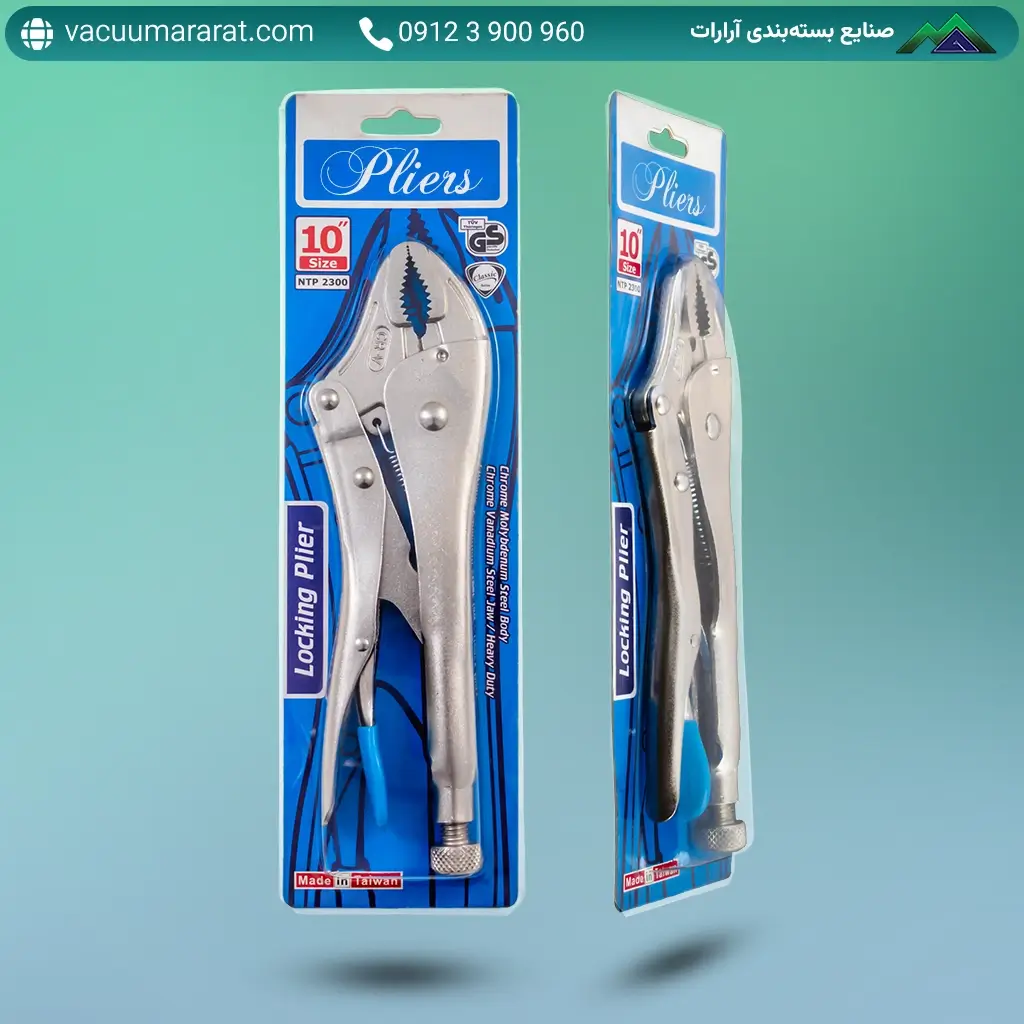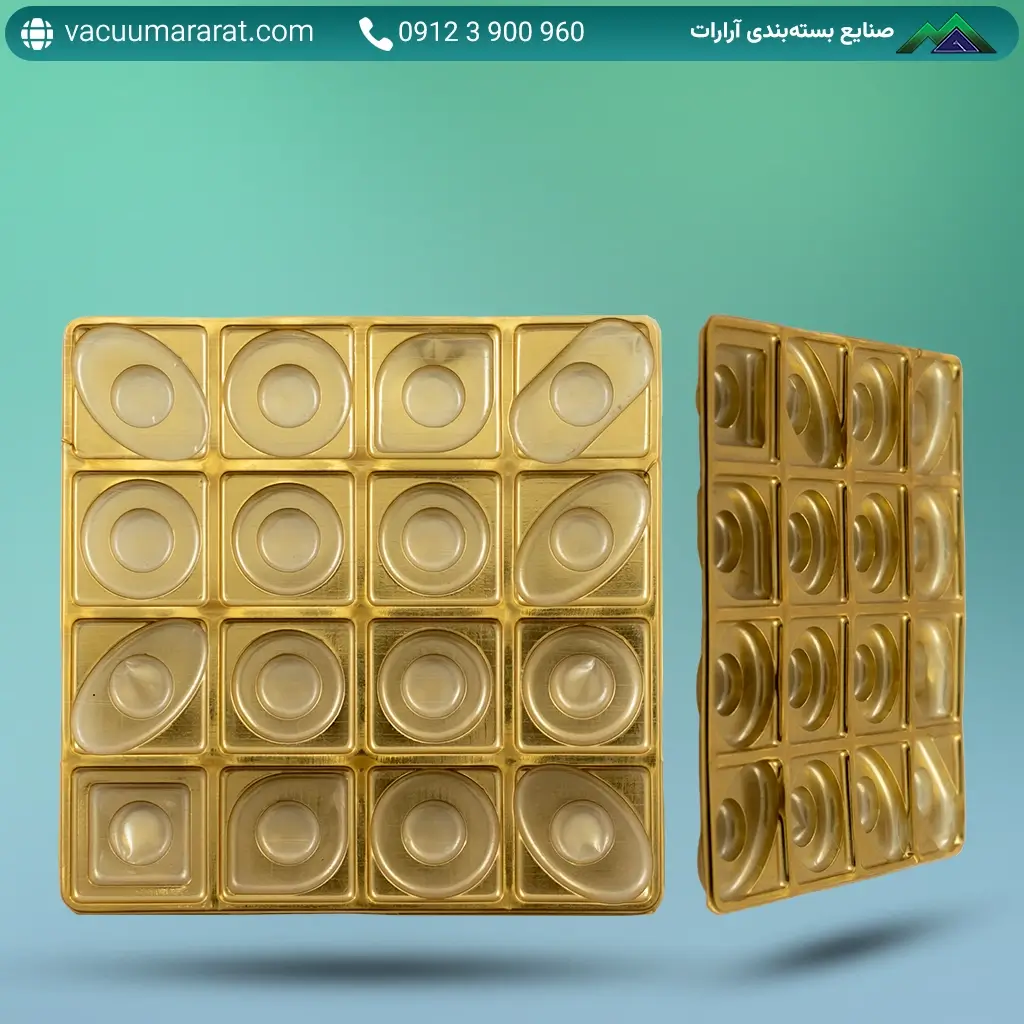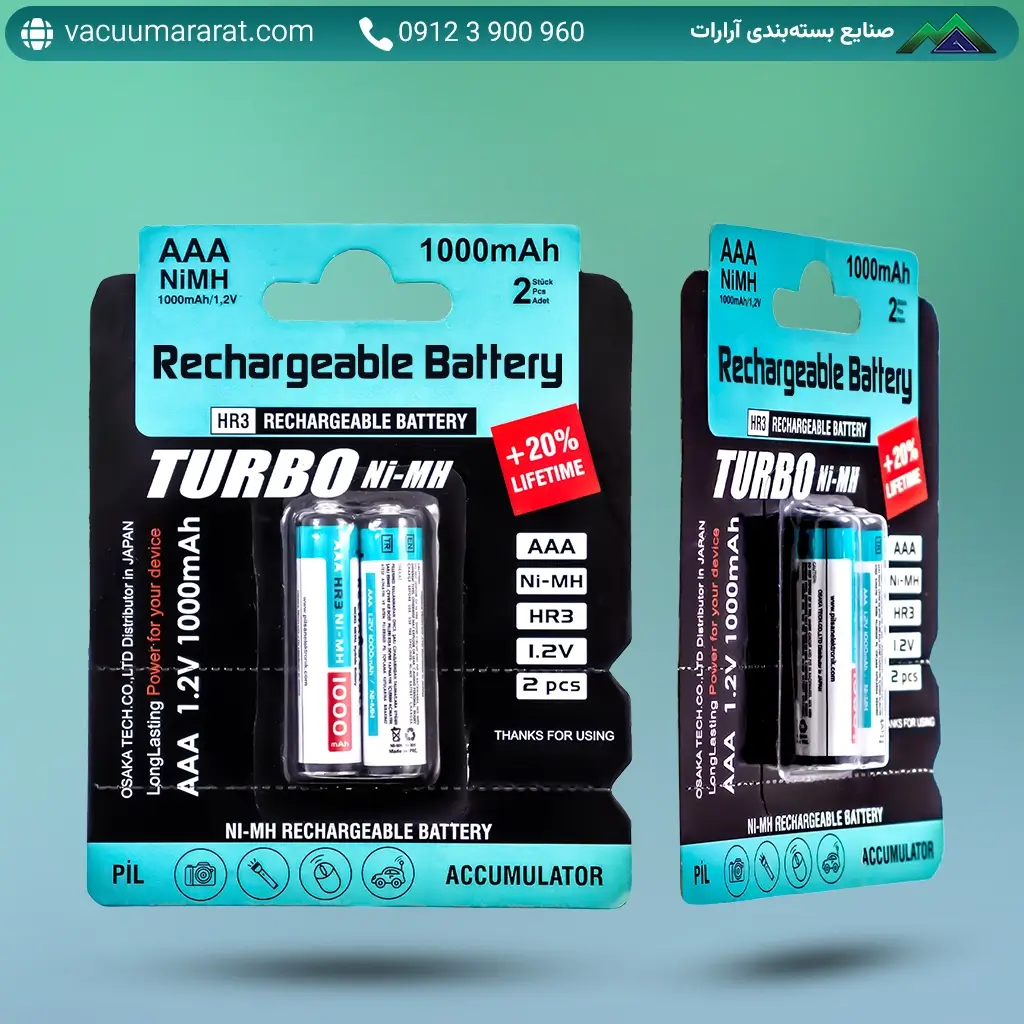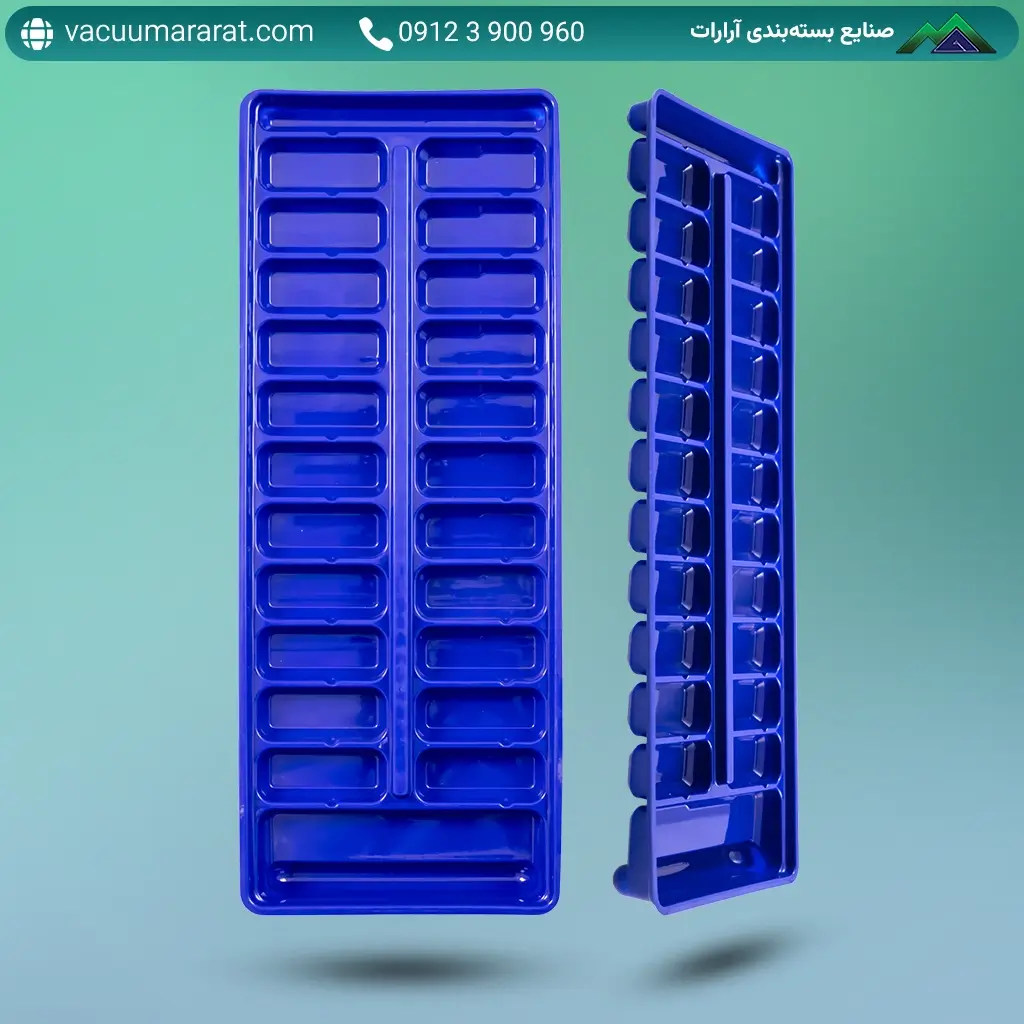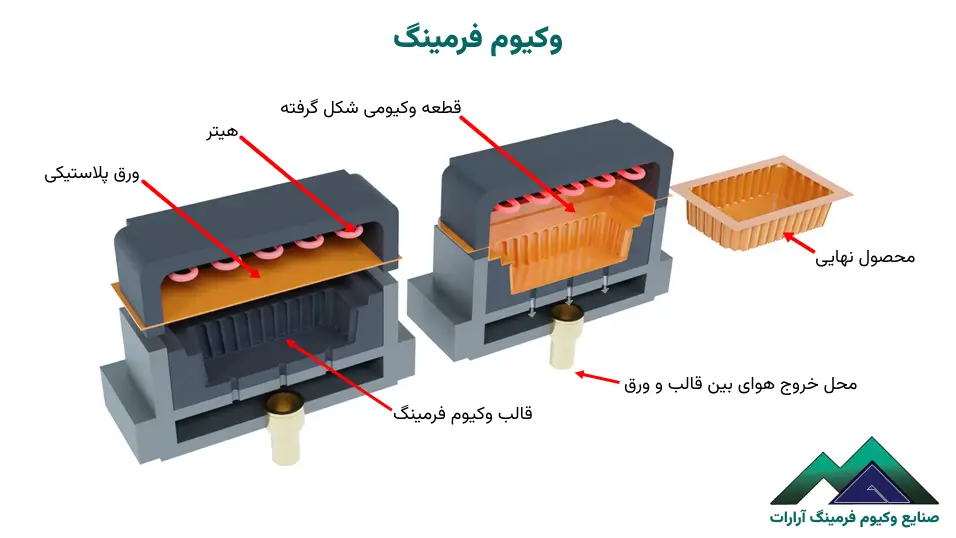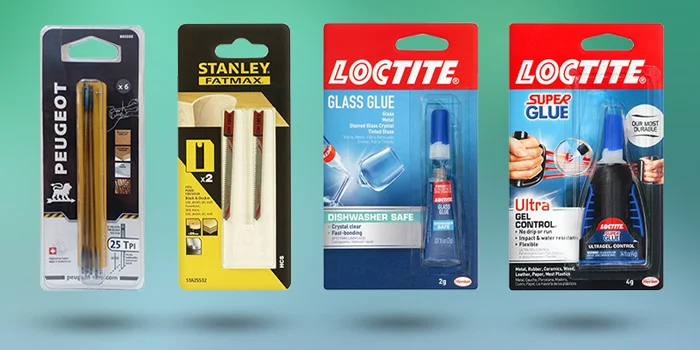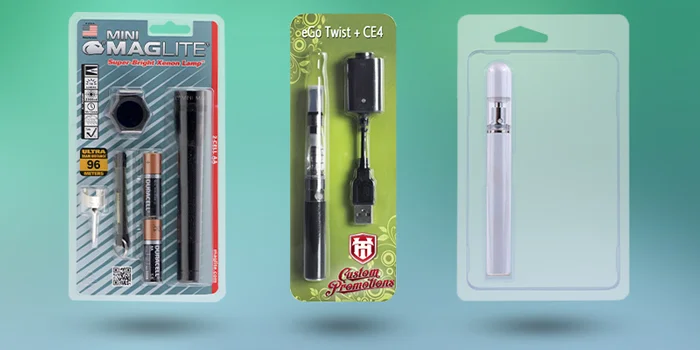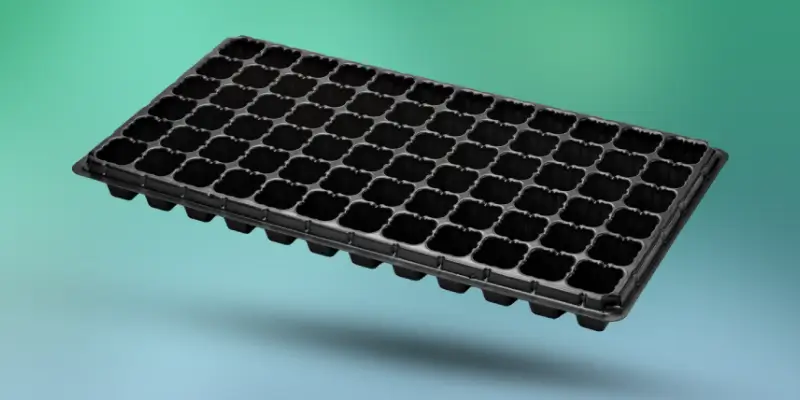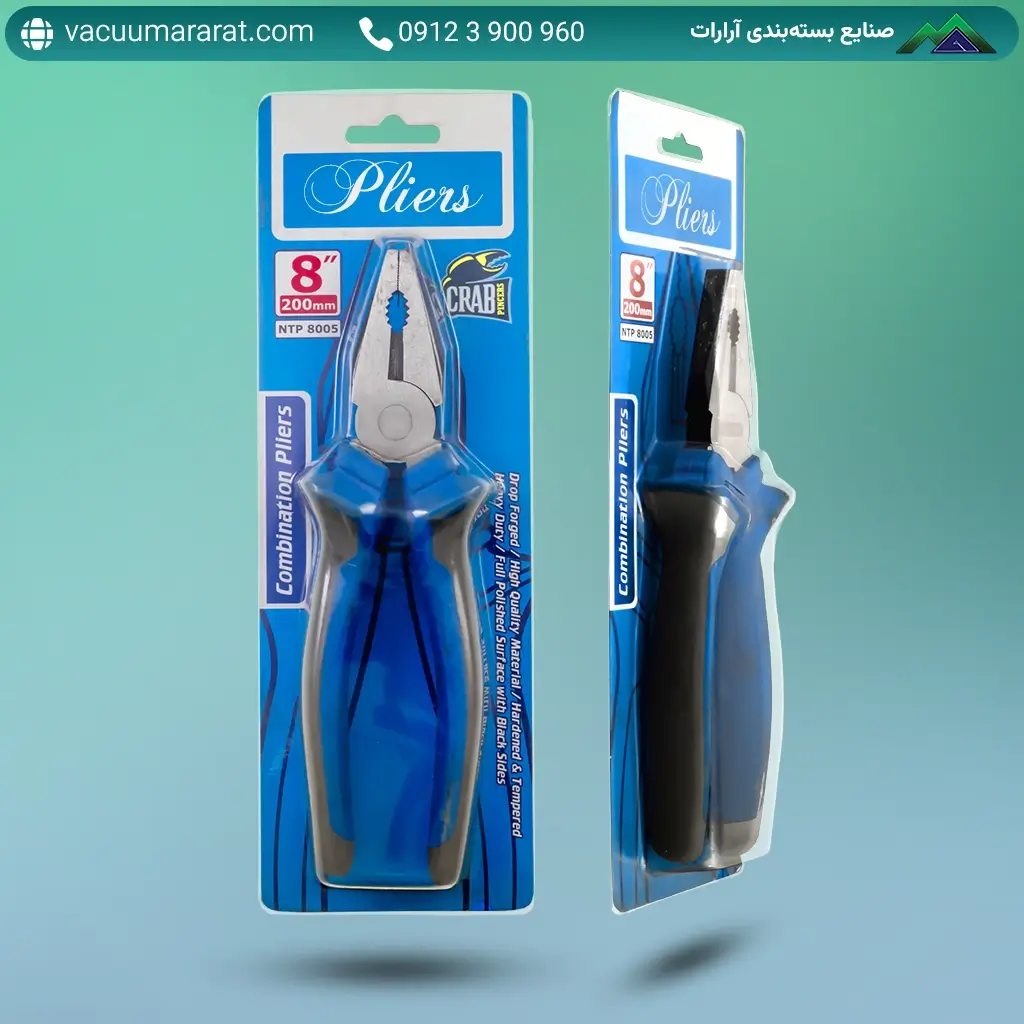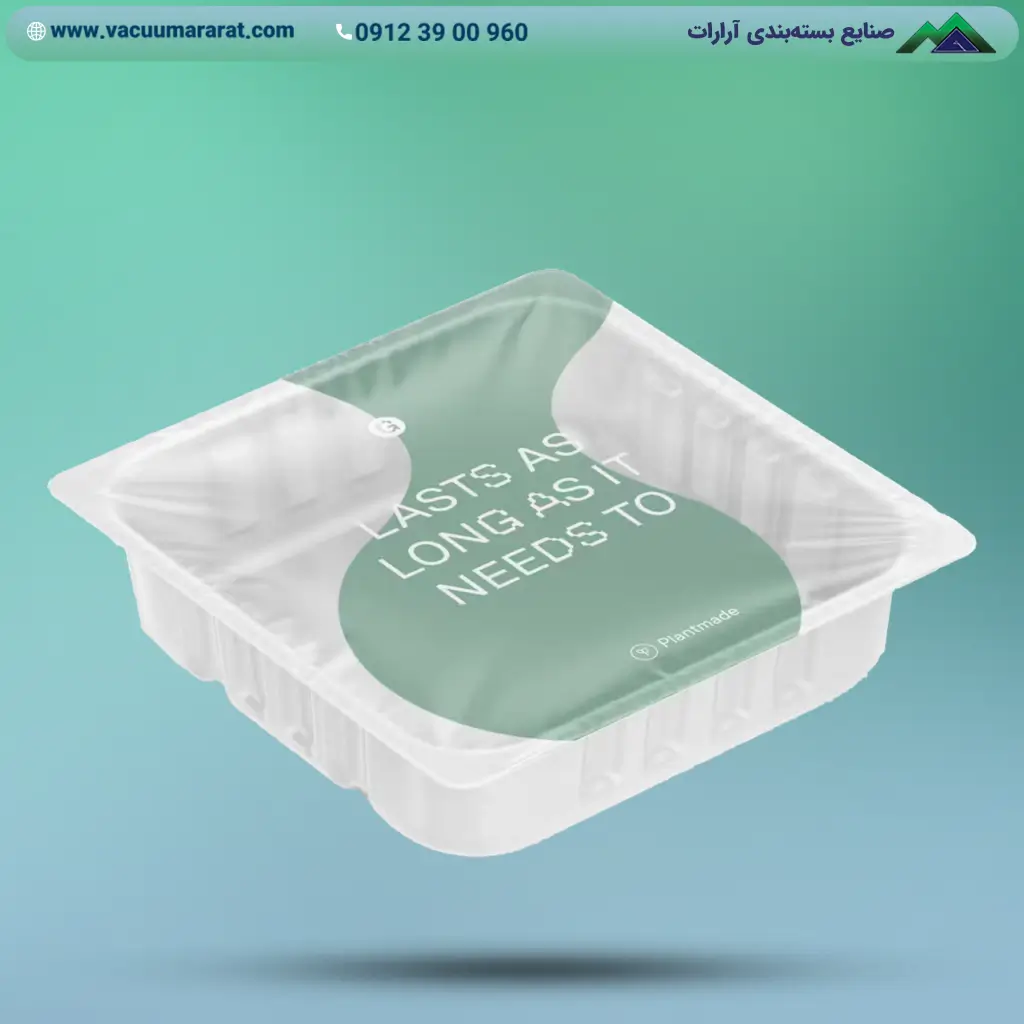
- خدمات بسته بندی وکیوم فرمینگ بلیستر پرسی، کشویی، هایفرکانس، لولایی، استند و اسکین
- تولید انواع قطعات وکیوم فرمینگ ABS , HIPS , PS , PET , PVC
- طراحی و ساخت قالبهای وکیوم فرمینگ CNC
- تولید و فروش ورق هایمپک (HIPS) در ضخامتهای مختلف
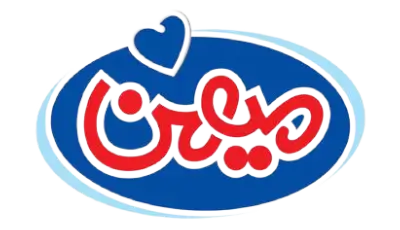






وکیوم فرمینگ و صنایع بسته بندی آرارات با مدیریت مهندس لِویک شیروانیان به لطف یزدان سپنتا بیش از ۲۳ سال در زمینه تولید قطعات وکیوم فرمینگ، بسته بندی وکیوم فرمینگ و جعبه طلقی (دایکات) دارای سابقه و تجربه پیروزمندانه است.
این مجموعه یکی از شرکتهای برتر و شناخته شده در صنعت وکیوم فرمینگ است و با اندوختهای گرانبها از دانش فنی و تجربه یکی از شرکتهای پیشرو در این حوزه میباشد و افتخار همکاری با برندهای مطرح همچون لبنیات روزانه، لبنیات بل، بلور کاوه و محصولات آرایشی مای را در کارنامه خود دارد.
ما با بهره گیری از تکنولوژیهای نوین، تضمین کیفیت محصولات و خدمات خود را به مشتریان ارائه میکنیم. همچنین با بکارگیری تجهیزات پیشرفته، به صورت حرفهای و با دقت بالا، محصولات مورد نظر مشتری را بسته بندی و ارائه میکنیم.
طی سالهای پیروزمندانه گذشته تا امروز، آرارات با سابقه و تجربه خود در این حوزه، همواره در تلاش است تا با ارائه خدماتی با کیفیت بالا و قیمت مناسب، اعتماد و رضایت مشتریان خود را به دست آورد و رویای رسیدن به رتبهی برتر در صنعت بسته بندی را به واقعیت تبدیل کند.
ما در این مسیر استوار و پابرجا خواهیم ماند.
بیش از دو دهه تجربه علمی و فنی
ما بیش از ۲۳ سال در صنعت وکیوم فرمنیگ و بسته بندی وکیوم فرمینگ سابقه داریم و یکی از شرکتهای برتر در این حوزه هستیم.
تضمین کیفیت
ما با بهرهگیری از تکنولوژیهای نوین و متخصصین ماهر، کیفیت محصولات و خدمات خود را تضمین میکنیم.
خط تولید دقیق و پیشرفته
دستگاهها و ماشینآلات خط تولید ما از آخرین تکنولوژی روز دنیا پیروی میکنند.
مشاوره، طراحی و اجرای منحصر به فرد
آرارات از ۰ تا ۱۰۰ کار کنار شماست تا به بهترین نتیجه و محصول نهایی دست یابید.
استفاده از مواد اولیه مرغوب
ما از مواد اولیه با کیفیت در تولیدات خود استفاده میکنیم تا کیفیت محصول نهایی مطلوب باشد.
توان تولید در تعداد بالا
خط تولید ما دارای ظرفیت بالایی است و توانایی پاسخگویی به مشتریان بزرگ را داراست.
تلاش برای رضایت مشتری
ما با ارائه خدمات با کیفیت و قیمت مناسب، همواره در تلاشیم تا اعتماد و رضایت مشتریان را به دست آوریم.
زمانبندی دقیق
ما با ارائه خدمات با زمانبندی تحویل دقیق، نیازهای مشتریان را در تمامی مراحل کار برآورده میکنیم.
بهره گیری از فن آوری روز دنیا
ما همواره تلاش کردهایم تا با تحقیق در زمینه کاریمان آگاهی و دانش خود را به روز نگهداریم.
نمونه کارها بصورت دسته بندی شده هستند برای مشاهده نمونه کارهای هر دسته بر روی آن کلیک کنید.
وکیوم فرمینگ
وکیوم فرمینگ، یک روش ساده برای شکلدهی به مواد گرمانرم و ترموپلاستیک است، که به منظور تولید بستهبندی وکیوم فرمینگ و قطعات وکیوم فرمینگ ضخیم و نازک، به کار میرود.
این روش معمولاً برای تولید قطعاتی که نیاز به شکلدهی خاص دارند، از جمله بستهبندی کالاها و قطعات مختلف، به کار میرود.
وکیوم فرمینگ، یکی از بهترین و اقتصادیترین روشهای تولید بستهبندیهای طلقی شفاف، مقاوم، انعطافپذیر، دقیق، مهندسیشده، زیبا و کمهزینه است.
این فرآیند با استفاده از قالبهای CNC و مواد اولیه گرمانرم مانند PET، HIPS، PVC و ABS برای بستهبندی محصولات متنوع از جمله لوازم آرایشی و بهداشتی، ابزارآلات، محصولات الکترونیکی و خودرویی، اسباببازی، میوه، آجیل، شکلات و شیرینی، تخممرغ، مواد غذایی و قطعات پلاستیکی ضخیم و ظروف یکبار مصرف استفاده میشود.
به وبسایت صنایع بستهبندی آرارات خوش آمدید. در اینجا، قصد داریم در مورد دو مبحث مهم، یعنی «وکیوم فرمینگ» و «بستهبندی وکیوم فرمینگ» به شما توضیحاتی ارائه دهیم.
امیدواریم این مطالب برای شما مفید واقع شود و به عنوان یک راهنمای جامع و مناسب برای بستهبندی محصولات یا تولید قطعات مورد نیاز شما عمل کند.
همراه ما باشید و از اطلاعات جدید و مفید بهرهمند شوید.
فهرست محتوا
وکیوم فرمینگ چیست؟
وکیوم فرمینگ فرآیندی است که در آن، یک ورق از مواد ترموپلاستیک با دمای مشخص، به حد کافی حرارت داده میشود تا انعطافپذیر و نرم شود. سپس، توسط فشار خلاء و قالب آلومینیومی، شکلدهی میشود.
این عملیات با استفاده از مکش منفی هوا (شکلدهی حرارتی خلا) بین قالب و ورق انجام میشود، که منجر به جذب و فرمدهی دقیق ورق بر روی قالب میشود.
به طور کلی مراحل وکیوم فرمینگ به شکل زیر است:
۱. در ابتدا، برای قطعه یا محصول مورد نظر، یک قالب آلومینیومی طراحی میشود، سپس قالب CNC بر روی دستگاه وکیوم فرمینگ بسته میشود.
۲. در ادامه یک رول ورق از مواد ترموپلاستیک مانند PET، PVC، HP، HIPS، ABS و … در قسمت ورقگیر دستگاه قرار میگیرد.
۳. دستگاه وکیوم فرمینگ رول ورق ترموپلاستیک را باز میکند و آن را در محفظهای حرارت میدهد تا ورق گرم و نرم شود. سپس، با حرکت قالب به سمت ورق گرم شده، ورق فرم قالب را میگیرد و به سرعت توسط یک دریچه خلاء، هوای مابین قالب و ورق خالی میشود. جهت حفظ این حالت، ورق پلاستیکی سریعاً توسط خنک کننده سرد شده و از قالب جدا میشود و سپس به قسمت برش هدایت میشود.
انواع بسته بندی وکیوم فرمینگ
۱۱ راه برتر بسته بندی وکیوم فرمینگ:
بلیستر کارتی پرسی
بسته بندی وکیوم فرمینگ بلیستر پرسی برای کالاهای سبک وزن استفاده میشود. در این نوع بسته بندی، یک قطعه وکیومی روی مقوای چاپ شده که دارای چسب بلیستر است، با استفاده از دستگاه پرس حرارتی پرس میشود. معمولاً در بالای این بسته بندی، یک سوراخ برای آویزان کردن در فروشگاه ایجاد میشود.
بلیستر میانکارتی
بسته بندی وکیوم فرمینگ بلیستر میان کارتی یا بین کارتی برای بسته بندی محصولات سبک مختلفی مورد استفاده قرار میگیرد. ساختار این بسته بندی شامل یک قطعه وکیومی و دو کارت مقوایی است که قطعه وکیومی بین دو کارت قرار گرفته و پرس میشود. قسمت برجسته قطعه وکیومی از پنجرهای که در یکی از کارتهای مقوایی تعبیه میشود بیرون میآید و محصول را به نمایش میگذارد.
کارتی کشویی
بسته بندی وکیوم فرمینگ کشویی برای بسته بندی کالاهای مختلفی استفاده میشود. در این روش، یک کارت مقوایی به صورت کشویی درون یک قطعه وکیومی که سه طرف آن به صورت خم شده است، قرار میگیرد. معمولاً یک سوراخ در بالای بسته بندی ایجاد میشود که امکان آویزان کردن آن در فروشگاه را فراهم میکند.
هایفرکانس
بسته بندی وکیوم فرمینگ هایفرکانس از دو قطعه وکیومی و یک کارت مقوایی که بین دو قطعه قرار میگیرد تشکیل میشود. دو قطعه وکیومی با استفاده از دستگاه هایفرکانس به یکدیگر چسبانده میشوند، این چسباندن با استفاده از فرکانس بالا و حرارت انجام میشود.
استند جعبهای
بسته بندی وکیوم فرمینگ استند جعبه ای به نوعی مکمل جعبههای مقوایی است که در آن قطعه وکیومی به عنوان مقسم یا نگهدارنده داخل جعبه مقوایی دارای درب قرار میگیرد. و برای بسته بندی محصولات لوازم آرایشی و شیرینی و شکلات، اسباب بازی، محصولات دارای قطعات چندگانه و غیره مورد استفاده قرار میگیرد.
استند نگهدارنده محصول
بسته بندی وکیوم فرمینگ استند نگهدارنده معمولا برای نمایش و نگهداشتن لوازم آرایشی و بهداشتی مورد استفاده قرار میگیرد. و به عنوان یک نگهدارنده، برای عرضه و نمایش لوکس محصولات به صورت دسته جمعی در داروخانهها و فروشگاهها استفاده میشود.
صدفی یا تاشو ظرفی
بسته بندی وکیوم فرمینگ تاشو از یک ظرف یکپارچه دو قسمتی (محفظه و درب) تشکیل میشود، که محفظه و درب آن میتوانند به صورت لولایی باز و بسته شوند. همچنین، این نوع بسته بندی بعد از استفاده نیز قابل استفاده مجدد است و برای بسته بندی محصولاتی مانند تخممرغ، خشکبار و میوه استفاده میشود.
صدفی یا تاشو کارتی
بسته بندی وکیوم فرمینگ تاشو کارتی نیز دارای دو بخش محفظه و پوشش پشتی به صورت لولایی یا تاشو است. پوشش یا درب پشتی را میتوان به صورت چفتی و یا هایفرکانس به قسمت محفظه مهر و موم کرد و همچنین میتوان در داخل بسته بندی کارت مقوایی نیز استفاده کرد.
ظروف درب دار
بسته بندی وکیوم فرمینگ ظروف درب دار شامل ظرف و درب وکیومی جدا از هم میباشد. محصول درون محفظه قرار میگیرد و سپس درب بر روی محفظه بسته میشود. ظروف درب دار در بسته بندی چاشنیهای غذا در رستورانها و فستفودها، و همچنین برای بسته بندی محصولات دیگر استفاده میشود.
وکیوم فرمینگ ظروف قابل سیل
این نوع بسته بندی مشابه یک ظرف سینی شکل است که محصول درون آن قرار میگیرد، سپس برای پوشش سینی و بستن آن از سیل یا سلفون استفاده میشود. این نوع بسته بندی عمدتا برای بسته بندی قارچ، میوه، گوشت و مرغ و محصولات مشتق شده از گوشت و مرغ به کار میرود.
اسکین
در این نوع بسته بندی، محصول روی یک کارت مقوایی چیده میشود و سپس یک ورق پلاستیکی شفاف روی آن وکیوم میشود. وکیوم اسکین را بسته بندی محصولات مختلف و قطعات چندگانه میتوان استفاده کرد. در این نوع بسته بندی نیاز به قالب آلومینیومی وجود ندارد.
مراحل بسته بندی وکیوم فرمینگ
بسته بندی وکیوم فرمینگ مراحل متعددی را شامل میشود که ما این مراحل را به سه بخش تقسیم کردهایم. با ما همراه باشید تا این بخشها و مراحل را بررسی کنیم.
بخش اول (مراحل اولیه):
۱. بررسی محصول
در ابتدا، محصولی که برای آن بسته بندی را انجام میدهیم، باید به طور کامل از نظر ابعاد، وزن و حجم مورد بررسی قرار گیرد تا اطلاعات لازم برای انتخاب نوع ورق پلاستیکی و ساخت قالب به دست آید.
۲. مشخص نمودن نوع ورق
برای بسته بندی، انتخاب ورق پلاستیکی باید با توجه به نوع محصول انجام شود. به عنوان مثال، برای محصولات غذایی، استفاده از ورقهای بهداشتی ضروری است، در حالی که برای محصولاتی با وزن نسبتاً زیاد، از ورقهای ضخیم تر استفاده میشود. ورقهای پلاستیکی متنوعی از جمله HIPS، PVC، PET وجود دارند که هر یک ویژگیهای خاص خود را دارند.
۳. طراحی و ساخت قالب
قالب، بخش مهم و بسیار حیاتی در فرآیند وکیوم فرمینگ است و نیازمند دقت ویژه در ساخت آن است، زیرا که شکل نهایی بسته بندی محصول به وسیله آن ایجاد میشود. قالب با توجه به نوع محصول و نیازهای مشتری طراحی و ساخته میشود. برای ساخت قالب، از موادی مانند آلومینیوم و چوب استفاده میشود، بهطوریکه قالبهای چوبی معمولاً برای تولید نمونه اولیه مورد استفاده قرار میگیرند، در حالی که قالبهای آلومینیومی برای تولید انبوه و بزرگتر استفاده میشوند.
بخش دوم (مراحل اصلی):
این بخش شامل مراحل اصلی شکلدهی به ورق پلاستیکی است که توسط اپراتور و دستگاه وکیوم فرمینگ انجام میشود.
۱. بستن قالب روی دستگاه وکیوم
قبل از شروع فرآیند، قالب باید به طور محکم و پایدار روی قالببند دستگاه وکیوم فرمینگ قرار گیرد تا فرایند شکلدهی به درستی انجام شود.
۲. قرار دادن رول ورق پلاستیکی در قسمت ورقگیر دستگاه
ابتدا، ورق پلاستیکی مورد نظر به صورت رول یا شیت در قسمت ورقگیر دستگاه قرار میگیرد.
۳. حرارت دهی به ورق
پس از انجام مراحل اولیه، مراحل اصلی شکلدهی به ورق با اعمال حرارت به ورق پلاستیکی آغاز میشود. این عملیات با استفاده از هیتر دستگاه وکیوم فرمینگ به صورت دقیق و مشخص انجام میشود.
۴. بالا آمدن قالب
پس از اعمال حرارت به ورق، دستگاه قالب را بالا میبرد و آن را به ورق گرم شده میچسباند.
۵. وکیوم فرمینگ و شکلدهی
پس از چسبیدن قالب به ورق، هوای بین قالب و ورق توسط پمپ وکیوم دستگاه کشیده و تخلیه میشود. با این عملیات ورق گرم بر روی قالب سرد مینشیند و شکل قالب را به خود میگیرد.
۶. سرد کردن و آزاد سازی قطعه شکل گرفته
پس از اتمام فرایند شکلدهی ورق، دستگاه با استفاده از پیستولههای آب و هوا، قطعه شکل گرفته را سرد میکند. سپس با عملیات فوت (دهش یا جریان مثبت هوا به سمت قالب) قطعه از قالب جدا میشود.
۷. برش قطعه شکلدهی شده
در پایان قطعه شکلدهی شده توسط کاتر دستگاه برش داده میشود تا از فرایند جدا شود.
بخش سوم (مراحل پایانی):
در این بخش، فرآیندهای برش قطعات، بستهبندی، و مونتاژ انجام میشود.
۱. برش اضافات
در این مرحله، اضافاتی که در قطعه شکلدهی شده وجود دارند، با استفاده از دستگاه پرس و تیغ برش مخصوص حذف میشوند. در صورتی که نیاز به سوراخ کاری باشد، نیز در این مرحله انجام میپذیرد.
۲. بسته بندی و مونتاژ
در مرحله پایانی، اگر نیاز به مهر و موم باشد، این عملیات بر روی بستهبندی انجام میشود. همچنین، مونتاژ قطعات و یا کارتهای چاپ شده همراه با بستهبندی نهایی محصول انجام میشود و در نهایت کار به اتمام میرسد و محصول به مشتری تحویل داده میشود.
مزایای بسته بندی وکیوم فرمینگ
مزایای بستهبندی وکیوم فرمینگ فراوان است. این روش با سرعت، کارآیی، و پرکاربردی خود، به همراه هزینه کم، یکی از بهترین انتخابها برای تولید قطعات بستهبندی محسوب میشود.
این فرایند از تکنولوژی پیشرفتهای بهره میبرد که برای تولید قطعات دقیق و با کیفیت بسیار مناسب است.
سرعت بالا و هزینه کمتر نسبت به روشهای دیگر مانند تزریق پلاستیک، از جمله مزایای این روش است. به همین دلیل، بستهبندی وکیوم فرمینگ به عنوان یکی از بهترین و موثرترین روشها برای بستهبندی قطعات شناخته میشود.
صرفه جویی در هزینه
بستهبندی وکیوم فرمینگ یکی از روشهای مقرون به صرفه برای نمایش و فروش محصول میباشد. این نوع بستهبندی، با توجه به ماهیت مواد، طراحی، و فرایند تولید، نسبت به بستهبندیهای دیگر که در بازار موجودند، مقرون به صرفهتر است.
این ارزیابی به دلیل سادگی فرایند و ابزارهای تولید این نوع بستهبندی انجام شده است که از لحاظ هزینه نیز نسبتاً ارزان محسوب میشوند.
فضای تبلیغاتی عالی
تنوع مناسبی از روشهای بستهبندی وکیوم فرمینگ وجود دارد که با استفاده از آنها میتوان طرحها و رنگهای متنوعی را برای بستهبندی محصول انتخاب کرد.
به عنوان یک مثال، بستهبندیهای ترکیبی با مقوا میتوانند فضای تبلیغاتی بسیار مناسبی را ایجاد کنند. این امکان به تولیدکنندگان فرصت میدهد تا از این مزیت برای ارتقای برند خود، تبلیغات و بازاریابی استفاده کنند.
با این روش، تولیدکنندگان میتوانند محصولات خود را در قفسههای فروشگاه به نمایش بگذارند و وفاداری مشتریان خود را افزایش دهند.
بسته بندی شفاف
بستهبندی وکیوم فرمینگ به صورت شفاف ارائه میشود، این ویژگی به مشتریان امکان مشاهده محصول و بررسی کیفیت آن را میدهد.
براساس تحقیقات انجام شده، بیش از نیمی از مشتریان ترجیح میدهند قبل از خرید محصول را ببینند و سپس تصمیم خرید را بگیرند.
این مزیت مشتریان را به خرید ترغیب میکند و در فرآیند تصمیمگیری آنها را یاری میکند. از نگاهی دیگر، بستهبندی شفاف به نوعی نماد راستی و شفافیت است و اعتماد افراد را جلب میکند.
جلوگیری از سرقت
در خرده فروشیها ممکن است محصولات کوچک و ریز به راحتی دزدیده شوند.
برای این نوع محصولات، میتوان بستهبندی وکیوم فرمینگ را به طوری طراحی کرد که اندازهی مناسب و خاصی داشته باشد.
این نوع بستهبندی اجازه میدهد که مشتریان فقط محصول را ببینند و قابلیت لمس و احساس آن را نداشته باشند.
بنابراین این نوع بسته بندی ضمن شفاف و قابل مشاهده و مقاوم بودن میتواند امنیت محصول را نیز حفظ می کند.
جلوگیری از دستکاری محصول
برای برخی از محصولات مانند مواد غذایی یا محصولات دیگر که امکان دستکاری، کپی یا جعل آن وجود دارد، تولید کنندگان میتوانند از بستهبندی وکیوم فرمینگ به همراه دوخت حرارتی هایفرکانس استفاده کنند تا محصولاتشان بدون دستکاری و با کیفیت به دست مشتری برسد.
همچنین، برای اطمینان از عدم دستکاری یا جعل محصول، میتوانند از برچسبی با عنوان «در صورت باز بودن یا برش در بستهبندی، از خرید آن صرفنظر کنید» استفاده نمایند.
محافظت از محصول
بستهبندی وکیوم فرمینگ به عنوان یک روش حفاظتی بسیار مؤثر برای محصولات شناخته میشود. این نوع بستهبندی، علاوه بر ارائه محصول به شکل بهتر و جذابتر، کیفیت و طول عمر آن را نیز به خوبی حفظ میکند.
بنابراین، از آنجایی که بستهبندی وکیوم فرمینگ به عنوان یک روش موثر برای حفظ کیفیت و جلب توجه مشتریان به محصولات شناخته میشود، توصیه میشود که در استراتژی بازاریابی خود از این روش استفاده کنید.
دقت و سرعت بالا
قطعات و بسته بندی های تولید شده با فرآیند وکیوم فرمینگ در مقایسه با ترکیب قطعات چندگانه و محصولاتی که با تزریق یا قالب گیری ساخته میشوند، بسیار دقیقتر و زیباتر هستند. زیرا به صورت یک قطعه و یکپارچه ساخته میشوند.
استفاده از فرآیند وکیوم فرمینگ منجر به کاهش خطا در فرآیند تولید میشود و هیچ فاصلهای بین طرح اولیه و محصول نهایی وجود ندارد. بنابراین کاهش خطا باعث افزایش دقت و سرعت تولید میشود.
طراحی انعطاف پذیر
طراحی انعطافپذیر در فرآیند وکیوم فرمینگ به این معناست که با استفاده از طراحی و ساخت قالب، میتوان نواقص را برطرف کرده و در نهایت به طرح مناسب و مطابق با نیازهای مشتریان دست یافت.
به همین دلیل، این نوع بستهبندی انعطافپذیری بالایی در طراحی و اجرا دارد، که این امکان را فراهم میکند که فرآیند تولید بهروز و با توجه به نیازهای بازار پیش برود.
صرفه جویی در زمان
از آنجا که زمان یکی از داراییهای گرانبهاست، وکیوم فرمینگ به عنوان روشی اقتصادی و سریع برای تولید قطعات پلاستیکی و بستهبندی شناخته میشود که به مدیریت بهتر وقت و افزایش بهرهوری کمک میکند.
این فرایند بسیار ساده است و زمان کمی که بین طراحی و تولید نهایی محصول در آن صرف میشود، بنابراین شما میتوانید در کمترین زمان ممکن محصول خود را بستهبندی و به بازار عرضه کنید.
کاهش حجم بسته بندی و هزینه حملونقل
بستهبندی وکیوم فرمینگ با کاهش حجم بسته بندی محصولات، امکان حمل و نقل با تعداد بیشتری را فراهم میکند و هزینههای حمل و نقل را کاهش میدهد.
افزایش عمر مفید محصول
بسته بندی با حفظ تازگی و کیفیت محصول و جلوگیری از اکسیداسیون و پوسیدگی، میتوان عمر مفید محصول را افزایش داد.
طراحی شیک و زیبا
این بسته بندی با طراحی دقیق و انعطاف پذیر، بستهبندیهایی شیک و جذاب ایجاد میکند که نه تنها محصول را به نمایش میگذارد، بلکه به جذب مشتریان جدید و حفظ مشتریان فعلی نیز کمک میکند.
کابردها و موارد استفاده
بسته بندی و نمایش محصول
امروزه، بسیاری از محصولات مورد استفاده روزمرهمان، از جمله لوازم آرایشی، بهداشتی، ریشتراش، مسواک و سایر وسایل مصرفی، از روش بسته بندی وکیوم فرمینگ استفاده میکنند.
بسته بندی مواد غذایی
اکثر بسته بندی های مواد غذایی با استفاده از روش وکیوم فرمینگ صورت میپذیرد؛ این روش از مواد بهداشتی در فرایند بستهبندی استفاده میکند.
بطور معمول، ظروف میوه، جعبههای پلاستیکی تخممرغ و ظروف یکبار مصرف غذا با این روش تولید میشوند. استفاده از این روش برای بستهبندی شیرینی و شکلات، میوه، تخممرغ، خشکبار و آجیل بسیار رایج است.
بسته بندی کالاهای مصرفی
بسیاری از کالاهای مصرفی از جمله وسایل الکترونیکی، اسباب بازی، و ابزارآلات، از روش بستهبندی وکیوم فرمینگ بلیستر کارتی یا اسکین استفاده میکنند.
صنعت کشاورزی
وکیوم فرمینگ برای تولید سینیهای کشت نیز استفاده میشود که از مواد مقاوم در برابر اشعه ماوراء بنفش ساخته میشوند که در برابر پوسیدگی ناشی از نور خورشید مقاوم هستند و برای کاشت بذرهای مختلف در گلخانهها استفاده میشوند.
محصولات پزشکی و دارویی
وکیوم فرمینگ در صنعت پزشکی برای تولید سینیهای پزشکی و دندانپزشکی به کار میرود، این سینیها از مواد بهداشتی تولید میشوند و برای قرار دادن وسایل پزشکی در اتاق عمل استفاده میشوند.
بستهبندی لوازم آرایشی و بهداشتی
با استفاده از روش وکیوم فرمینگ، بسته بندی لوازم آرایشی و بهداشتی به شکلی کاملاً بهداشتی و جذاب صورت میگیرد که امکان نگهداری و استفاده آسان را فراهم میکند.
بستهبندی اسباب بازی
با استفاده از روش وکیوم فرمینگ، بسته بندی اسباب بازی ها به شیوهای امن و جذاب انجام میشوند که هم از نظر امنیت و حفاظت از محصول مؤثر است و هم به کودکان احساس لذت و ترغیب به بازی میدهد.
بسته بندی لوازم الکترونیکی و لوازم جانبی
وکیوم فرمینگ برای بسته بندی لوازم الکترونیکی و لوازم جانبی مورد استفاده قرار میگیرد. این روش محصولات را در برابر ضربه، رطوبت و گرد و غبار محافظت میکند، همچنین به زیبایی و حرفهای بودن محصولات کمک میکند.
روشهای مهر و موم بسته بندی وکیوم فرمینگ
بستهبندیهای وکیوم فرمینگ انواع مختلفی دارند که به روشهای مختلف مهر و موم و مونتاژ میشوند. در اینجا به صورت خلاصه به این روشها پرداخته میشود، برای اطلاعات بیشتر میتوانید به مقاله «انواع مهر و موم در وکیوم فرمینگ» مراجعه کنید.
۱. جوش هایفرکانس
در روش جوش هایفرکانس، محصول و یک کارت مقوایی چاپ شده بین دو قطعه وکیومی قرار میگیرند و سپس دو قطعه وکیومی با دستگاه جوش هایفرکانس به یکدیگر دوخته میشوند تا بستهبندی کامل گردد.
۲. پرس حرارتی
در روش پرس حرارتی، محصول بین یک قطعه وکیومی شکل داده شده و کارت مقوایی چاپ شده قرار میگیرد، سپس با استفاده از دستگاه پرس حرارتی، قطعه وکیومی و کارت مقوایی که دارای چسب بلیستر است، به یکدیگر پرس میشوند.
۳. مهر و موم بین کارتی
در روش مهر و موم بین کارتی، محصول و قطعه وکیومی بین یک کارت چاپ شده مخصوص قرار میگیرند و با چسب مخصوص به یکدیگر چسبانده میشوند. این روش برای بسته بندی محصولات کوچک مانند فلش مموری و غیره مناسب است.
۴. مهر و موم کشویی
در روش مهر و موم کشویی، یک مقوای چاپ شده به صورت کشویی داخل قطعه وکیومی که سه طرف آن خم شده است قرار میگیرد. محصول درون قطعه وکیومی قرار میگیرد و سپس مقوا به صورت کشویی درون قطعه وکیومی قرار میگیرد.
۵. مهر و موم چفتی
مهر و موم چفتی در بسته بندی وکیوم فرمینگ لولایی یا صدفی استفاده میشود.
این نوع بسته بندی شامل یک قطعه وکیومی صدفی است که یک طرف آن محفظه و طرف دیگر آن درب است. بیرونآمدگی و تو رفتگی در کنارههای درب و محفظه، باعث میشود در هنگام بسته شدن، درب و محفظه به یکدیگر چفت شوند.
۶. مهر و موم سیل
مهر و موم سیل در بستهبندی مواد غذایی استفاده میشود. در این روش، یک ورق پلاستیکی یا آلومینیومی چاپ شده روی یک ظرف وکیومی قرار میگیرد و با دستگاه مخصوص سیل میشود.
مواد اولیه و متریال وکیوم فرمینگ
ترموپلاستیک یا پلاستیک گرمانرم مادهای پلیمری است که با اعمال گرما قابلیت شکلپذیری و نرمی پیدا کرده و پس از خنک شدن دوباره سفت و سخت میشود.
در صنایع بستهبندی و خدمات وکیومفرمینگ، ترموپلاستیکهای پت(PET) ، پیویسی(PVC) ، هایمپک(HIPS)، و ایبیاس(ABS) بیشترین کاربرد را دارند.
در ادامه، به بررسی این نوع ترموپلاستیکها میپردازیم.
پت (PET)
پت یا پلیاتیلن ترفتالات(Polyethylene Terephthalate) رایجترین ترموپلاستیک از خانواده پلیاسترهاست و دارای گرید بهداشتی است که برای برای بستهبندی مواد غذایی و پزشکی مناسب است.
پت ترکیبی از خواص مکانیکی و حرارتی عالی همراه با مقاومت شیمیایی و پایداری ابعادی بسیار خوب را دارا میباشد. همچنین، جذب رطوبت کمی دارد.
این ترموپلاستیک دارای مقاومت و استحکام بالا و از امکان پردازش و شکلدهی بسیار خوبی برخوردار است که آن را از دیگر ترموپلاستیکها متمایز میکند.
کاربرد در بستهبندی
- بستهبندی وکیوم تخممرغ
- بستهبندی وکیوم استند شیرینی و شکلات
- بستهبندی محصولات بهداشتی و لوازم آرایشی
- بستهبندی محصولات پزشکی
پی وی سی (PVC)
پی وی سی یا پلیوینیل کلراید(Polyvinyl Chloride) یکی از پرمصرفترین پلیمرهای جهان است.
این ماده به دلیل قابلیتهای چندمنظوره، کاربردهای فراوانی در صنایع مختلف، از جمله بستهبندی، دارد.
پی وی سی یک پلیمر بسیار بادوام و با ماندگاری بالاست که در ضخامتها و رنگهای متنوع موجود است.
کاربرد در بستهبندی
پی وی سی بیشتر برای بستهبندی محصولاتی مانند وسایل الکترونیکی، ابزارآلات و اسباببازیها استفاده میشود.
هایمپک (HIPS)
اچ آی پی اس یا هایمپک(High Impact Polystyrene) یکی از پلاستیکهای پرکاربرد و محبوب است که دارای گرید بهداشتی و مقاومت مناسب است.
این ترموپلاستیک در رنگهای متنوع و ضخامتهای 200 تا 1000 میکرون عرضه میشود. هایمپک به دلیل شکلپذیری آسان و خواص جریان خوب و آنتیاستاتیک، بسیار مورد استفاده قرار میگیرد.
کاربرد در بستهبندی
به دلیل بهداشتی بودن این ترموپلاستیک مانند PET، میتوان از آن برای تولید ظروف غذا و بستهبندی مواد غذایی، وسایل پزشکی، لوازم آرایشی و بهداشتی و دیگر محصولات استفاده کرد.
ای بی اس (ABS)
ای بی اس(Acrylonitrile Butadiene Styrene) مقاومت بسیار بالایی در برابر ضربه دارد و دارای کیفیت سطح فوقالعاده، پایداری رنگ و درخشش ایدهآلی است.
این ترموپلاستیک در ضخامتهای 1 تا 6 میلیمتر و در رنگهای سفید، مشکی و طوسی تولید میشود.
ABS شکلپذیری آسانی دارد، رطوبت هوا را جذب میکند و از دیگر مواد گرانتر است. وکیوم فرمینگ ABS به دلیل ضخامت بالا، کاربرد گستردهای در تولید قطعات ضخیم دارد.
کاربرد
به دلیل مقاومت بالا، از ABS برای ساخت قطعات وکیوم فرمینگ ضخیم، لوازم خانگی، کلاه ایمنی، دیوارههای دستگاههای الکترونیکی، قطعات داخلی یخچال، وان، پانلهای دیوارپوش و … استفاده میشود.
قالب وکیوم فرمینگ و متریال آن
طراحی و ساخت قالب، مهمترین بخش فرآیند وکیوم فرمینگ است. در این بخش، طرح مورد نظر به صورت یک شئ فیزیکی ساخته میشود تا برای شکلدهی به ترموپلاستیکها در فرآیند خلأ استفاده شود.
بدون قالب، امکان شکلدهی به ترموپلاستیکها وجود ندارد، بنابراین قالب از اهمیت بالایی برخوردار است.
قالب وکیوم فرمینگ باید به صورت استاندارد طراحی شود تا محصول باکیفیتی تولید کند. در غیر این صورت، قالب ممکن است در طول فرآیند، ثبات و شکل خود را از دست بدهد و در نهایت محصولی بیکیفیت و نامناسب حاصل شود.
چندین نکته مهم مانند شکل، متریال قالب، اندازه و حجم محصول در طراحی و ساخت قالب وجود دارد که باید مورد توجه قرار گیرند.
در ادامه به بررسی بیشتر این موضوع میپردازیم.
متریال قالب
منظور از متریال، مواد مورد استفاده در ساخت قالب است که معمولاً شامل آلومینیوم، چوب، امدیاف و… میباشد. در ایران بیشتر از آلومینیوم و چوب استفاده میشود.
آلومینیوم
قالب آلومینیومی برای تولیدات گسترده و تیراژ بالا بسیار مناسب است زیرا مقاومت بالایی دارد و در فرآیند وکیوم فرمینگ به راحتی گرما را دفع میکند.
این قالبها به دلیل استحکام بالا، ثبات و وزن سبک، برای تولیدات گسترده بسیار مطلوب هستند.
ساخت این قالبها به دو روش انجام میشود:
دستگاه سیانسی: ابتدا طرح سهبعدی با کامپیوتر طراحی و سپس توسط دستگاه سیانسی ساخته و ماشینکاری میشود.
ریختهگری: در این روش قالب با فرآیند ریختهگری ساخته میشود. این روش کمتر استفاده میشود و منسوخ شده است.
چوب
طراحی و ساخت قالب چوبی کم هزینه و آسان است و با استفاده از ابزارها و تکنیکهای مختلف میتوان آن را ساخت.
قالب چوبی معمولاً برای ساخت نمونههای اولیه از محصول استفاده میشود.
این قالبها به دلیل استحکام و ثبات کم، مناسب تولیدات زیاد نیستند زیرا در چرخه سرما و گرما تولید، منبسط و منقبض میشوند و ممکن است ترک بخورند.
در ساخت قالب چوبی میتوان از ابزارهای ساده نجاری و دستگاه سیانسی استفاده کرد.
دستگاههای وکیوم فرمینگ
به طور کلی، دستگاههای وکیوم فرمینگ به دو دسته نیمه اتوماتیک و اتوماتیک تقسیم میشوند که هر کدام ویژگیها و امکانات خاص خود را دارند.
دستگاههای نیمه اتوماتیک
این دستگاهها در اندازههای کوچک ساخته میشوند و عملکرد رضایتبخشی دارند، اما برای تولیدات انبوه مناسب نیستند، زیرا سرعت تولید و شکلدهی در آنها پایین است و نیاز به یک اپراتور دارند.
این دستگاهها با شیت ورق پلاستیکی تغذیه میشوند و شامل بخشهای قالببند، هیتر، گیره و پمپ خلا هستند.
مراحل کار به شرح زیر است:
- ابتدا قالب آلومینیومی در بخش قالببند بسته میشود.
- سپس شیت پلاستیکی روی دستگاه قرار میگیرد.
- هیتر توسط اپراتور روشن میشود تا ورق حرارت ببیند.
- بعد از حرارتدهی، قالب که زیر شیت قرار دارد بالا آمده و به شیت میچسبد. سپس عمل وکیوم فرمینگ انجام میشود تا هوای بین قالب و شیت تخلیه شود.
- پس از شکلگیری شیت و خنک شدن، قطعه شکل گرفته از قالب جدا میشود.
دستگاههای اتوماتیک
این دستگاهها در اندازههای بزرگ ساخته میشوند و برای تولیدات بالا مناسب هستند، زیرا سرعت تولید و شکلدهی در آنها بسیار بالاست و نیاز به دخالت کمتر اپراتور دارند.
این دستگاهها با رول پلاستیکی تغذیه میشوند و دارای بخشهای قالببند، هیتر، خنککننده، پمپ خلا، کاتر و نگهدارنده رول پلاستیکی هستند.
مراحل کار به شرح زیر است:
- ابتدا قالب در بخش قالببند بسته میشود.
- رول پلاستیکی در بخش نگهدارنده رول قرار میگیرد.
- مراحل بعدی توسط دستگاه انجام میشود که شامل حرارتدهی، شکلدهی، خنک کردن و برش قطعه شکل گرفته است.
خدمات وکیوم فرمینگ
خدمات ما در حوزه وکیوم فرمینگ شامل تولید قطعات و بستهبندیهای وکیوم فرمینگ است.
تولید قطعات وکیوم فرمینگ
ما با استفاده از مواد ABS، قطعات ضخیم وکیوم فرمینگ تولید میکنیم که دارای استحکام و کیفیت بالا هستند.
تولید بستهبندیهای وکیوم فرمینگ
ما انواع مختلف بستهبندیهای وکیوم فرمینگ را ارائه میدهیم، از جمله:
- بستهبندی بلیستر پرسی
- بسته بندی بلیستر میان کارتی
- کارتی کشویی
- هایفرکانس
- استند جعبهای
- استند نگهدارنده محصول
- صدفی یا تاشو ظرفی
- صدفی یا تاشو کارتی
- اسکین
ارتباط با ما
مجموعه آرارات با افتخار در تهران، قلب تپنده ایران، به ارائه خدمات وکیوم فرمینگ مشغول است. برای سفارش بستهبندی کالا، لطفاً از راههای ارتباطی موجود با ما تماس بگیرید.
استعلام قیمت وکیوم فرمینگ در Aug 2025
صنایع بستهبندی آرارات در تلاش است تا خدمات خود را با مناسبترین قیمتها به کسبوکارها ارائه دهد.
برای استعلام قیمت بستهبندی وکیوم فرمینگ، لطفاً موارد زیر را در نظر بگیرید و سپس با ما تماس بگیرید. کارشناسان ما آماده پاسخگویی به شما هستند.
عوامل مؤثر بر قیمت بستهبندی وکیوم فرمینگ
۱. اندازه و ابعاد محصول:
با افزایش اندازه و ابعاد محصول، مصرف مواد بستهبندی و زمان ساخت قالب و تولید بیشتر میشود، که تأثیر قابل توجهی بر قیمت دارد.
۲. نوع ورق بستهبندی:
نوع مواد بستهبندی مورد استفاده مانند پی وی سی، پت، پی اس و هایمپک تأثیر مستقیمی بر قیمت دارند. هر کدام از این مواد قیمت و ویژگیهای متفاوتی دارند.
۳. ضخامت ورق بستهبندی:
ضخامت ورق بستهبندی نیز تأثیر مهمی بر قیمت دارد. با افزایش ضخامت مواد، مصرف مواد بیشتر شده و ممکن است به افزایش قیمت منجر شود.
۴. تعداد قطعات بستهبندی:
تعداد و پیچیدگی قطعات بستهبندی تأثیر قابل توجهی بر قیمت دارد. بستهبندی با قطعات بیشتر یا اشکال و اندازههای مختلف هزینه و زمان تولید بیشتری را میطلبد.
۵. خدمات اضافی:
خدمات اضافی مانند طراحی، چاپ و مونتاژ نیز در پروسه تولید و قیمت تاثیرگذار هستند.
۶. حجم تولید:
حجم تولید و تعداد واحدهای بستهبندی نیز بر قیمت تأثیر میگذارد. سفارش حجم بیشتر ممکن است به مشتریان تخفیف و قیمت مناسبتری ارائه دهد.
برای استعلام قیمت دقیق، لطفاً با ما تماس بگیرید و جزئیات محصول خود را اعلام کنید.
سوالات متداول
تعریف ساده بستهبندی وکیوم فرمینگ؟
بستهبندی وکیوم فرمینگ روشی است که در آن از پلاستیک شفاف و شکلداده شده برای بستهبندی محصولات مختلف استفاده میشود.
قالب CNC وکیوم فرمینگ چیست؟
قالب وکیوم از جنس آلومینیوم است که طبق طراحی محصول مورد نظر با دستگاه CNC ساخته میشود. این قالب برای شکلدهی به ورق پلاستیکی در فرآیند وکیوم فرمینگ استفاده میشود.
چه نوع محصولاتی با وکیوم فرمینگ بستهبندی میشوند؟
این روش برای بستهبندی اسباببازیها، لوازم آرایشی-بهداشتی، شیرینی و شکلات، ابزارآلات، لوازم الکترونیکی و غیره کاربرد دارد.
آیا در بستهبندی وکیوم فرمینگ امنیت محصول حفظ میشود؟
بله، وکیوم فرمینگ با مهر و مومهای مختلف مانند هایفرکانس و پرسی میتواند امنیت محصول را در برابر دستکاری تأمین کند.
آیا بستهبندی وکیوم فرمینگ قابلیت بازیافت دارد؟
بله، بستهبندی وکیوم فرمینگ از پلاستیکهایی مانند PVC، PET، HIPS و ABS استفاده میکند که قابل بازیافت هستند.
آیا محصولات با بستهبندی وکیوم فرمینگ مناسب برای حمل و نقل بینالمللی هستند؟
بله، این بستهبندیها به دلیل استحکام بالا و کاهش حجم، برای حمل و نقل بینالمللی مناسب بوده و محصول را در برابر ضربه، رطوبت و خطرات حمل و نقل محافظت میکنند.
آیا بستهبندی وکیوم فرمینگ برای محصولاتی با اندازه و شکلهای مختلف مناسب است؟
بله، وکیوم فرمینگ با قالبهای سفارشی میتواند برای محصولات با اندازه و شکلهای مختلف استفاده شود، لذا روشی قابل اعتماد و مناسب برای بستهبندی محصولات متنوع است.
آیا بستهبندی وکیوم فرمینگ محصولات را در برابر ضربه و آسیبهای مکانیکی محافظت میکند؟
بله، این بستهبندی میتواند محصولات را در برابر ضربه و آسیبهای مکانیکی محافظت کند. با کاهش فضای خالی داخل بستهبندی، احتمال شکستن و آسیبدیدن محصول در حین حمل و نقل کاهش مییابد. با این حال، برای محافظت کامل، ترکیب با جعبههای محافظ و مواد بستهبندی پایدار توصیه میشود.
آخرین مقالات
How useful was this post?
Click on a star to rate it!
Average rating 5 / 5. Vote count: 16
No votes so far! Be the first to rate this post.
you are here: Home



